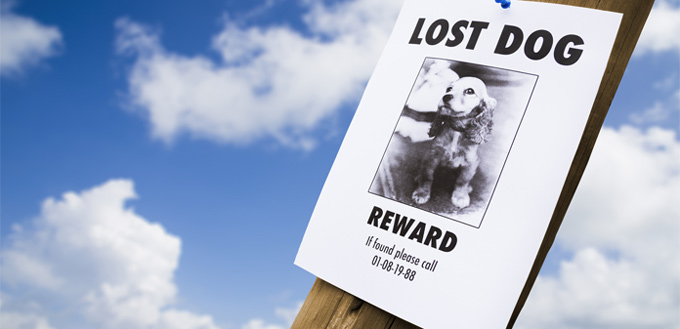It’s a painful feeling to lose a dog. Whether your best friend has escaped, was kidnapped or just got lost, it is sure to keep you awake all night long. But how can you find your dog? What is the chance to find your dog after a certain amount of time, say 24 hours?
Let’s find out. but before that, we look into some lost dog statistics to give you an idea.
Lost Dog Statistics
The American Society for the Prevention of Cruelty to Animals or the ASPCA in short, did a five-year study on missing pets, and it showed many surprising statistics.

Over the course of five years, the number of lost dogs and cats had greatly reduced and a high percentage of the lost pets were returned back to the owner. Other information from the survey include,
- Only 15% of pet owners reported a loss of their pets.
- 93% of dogs and 75% of cats who were reported missing were reunited with their respective owners
- Six percent of dog owners and two percent of cat owners found their pets at animal shelters.
- The study also showed that 15% of dogs returned to their owners because they were wearing some kind of identification tag.
- 16% of lost dogs manage to find their way back to their owners.
You May Also Like: Dog ID Tags
Further, the chances of finding your pet within your neighborhood within the first 12 hours, is 90%.
Before going on, let’s understand why your dog got lost in the first place.
How Dogs Get Lost?
Many times, the dogs just run away because of the availability of an opportunity, due to panic and or to follow their wanderlust instinct.
- Opportunity
Dogs, sometimes, leave for no apparent reason. You may be the best pet owner in the world, but that doesn’t mean your dog will not run away. It could run away simply because there was an opportunity to escape from a confined space.
On the other hand, if you’re an abusive pet owner who screams at your dog often or even worse, gets physical, then the dog is just waiting for a chance to escape.
Either way, you can’t control your dog from leaving you, if it wants to.
- Wanderlust
Wanderlust is an instinct to just wander. If you go back to the days when dogs were roaming in the wild, this kind of mindless wandering just made survival easier for them, as they learned to adapt to different environments. That instinct is a part of genes, and it continues even today, despite the fact that dogs are domesticated. This instinct is called wanderlust. To appease this instinct, dogs just wander out of their homes and go all over the place.
- Panic
Sometimes, dogs get scared when they hear a noise, lightning or just blind panic. This is more common when they hear thunder and see lightning. In their mad rush of fear and panic, they just run out of the house not knowing how else to overcome this fear of panic.
These are the three main reasons why dogs leave a home and get lost. Other possibilities include losing their way back or losing touch with the owner in a new place.
Finding a Lost Dog within 24 hours
The chances of finding your dog within 24 hours is about 90% and this chance goes down to about 55 to 65% after 24 hours. These chances dwindle further if you do not take any measures to find your dog.
Instead of waiting for your dog, here are some things you can do to find your dog.
- Stop searching and think
For a moment, stop your search and think. Where could you dog do? Which direction? How long could it travel?
Thinking about these answers can help you get to the dog soon. Also, it is best you take the help of others to lookout for your dog, Maybe each person can search in a different direction instead of one person traveling in all the directions.
When you stop for a moment, a fresh idea could pop in your mind too!
- Put up ads
A time-tested method to find lost dogs is to put up ads and flyers. Put an image of your dog and your contact number. Maybe even mention that the finder will be given a reward for their help. This could motivate people to return a lost dog to you.
You can publish your ad on traditional media like newspapers for maximum coverage within your locality. Alternately, you can also use social media and the Internet to post the ads, but make sure it is in a relevant group or page to greatly boost your chances of finding the dog.

You can even put it up on lamppost or have a big board right in front of your house, maybe in the driveway. Decide which are the most prominent places and put it up there. Also, make sure your flyers are attractive, so people stop to have a look at them.
- Contact the local shelters
Get in touch with the local shelters right away to see if someone has brought your dog there. Ideally, contact all shelters within a 20 mile radius, as the chances for your dog to travel beyond that is farfetched.
Even if they don’t have them, see if they would be willing to place one of your flyers on prominent places like the lobby.
Use Google search or ASPCA website to find the shelters in your neighborhood.
- Get in touch with the local vet
Just like shelters, your local vet office is also a good place to check for lost dogs. Many people tend to bring lost dogs to the local vet office, so it is a good place to check.
You can also request them to paste a copy of the flyer in their waiting room, so other animal lovers can help you to find your dog.
- Reach out to your neighbors
Statistics shows that most dogs are found in the neighborhood in which you live. Maybe the dog just wandered around or went out in a bad dash of panic and didn’t know the way back!
Reach out to your neighbors and see if they have seen your dog. If your local community has a social media group, post it on the group, so everyone can keep an eye out for your dog.
- Take professional help
There are a few companies that take the responsibility of finding the dog back for you. In return, you’re charged a fee for this service.
Take references for lost pet finding companies from your friends or simply use Google to get their contact information.
- Search at night
When your dog is lost, it will follow its natural instinct, which is to use the cover of darkness. So, search after the sun goes down and use a powerful torchlight to find your way.
Walk around your neighborhood and look keenly in bushes and other areas with dense vegetation. The chance for your dog to hide there is quite high.
- Never chase your dog
If your dog starts moving as soon as it sees you, never run or chase it. When the dog is lost, it gets stressed and anxious and may want to run away from you. Don’t take it personal, it’s just the dog expressing its anxiety.
Never move in that case and the dog will eventually come back to you. On the other hand, when you chase, the dog will get even more anxious and may never want to return to you!
- Keep familiar things
If you know the exact place where your dog got lost, keep a few of its favorite things or foods at that place. The chances are the dog will come back to the place where it lost you and will remain there. You go to that place and check if your dog is back. Do this at least once every few hours until you find your dog.
- Use social media
Use social media extensively to find your dog. Keep the dog or even better the flyer as your profile picture , so all your contacts will know that your dog is lost and you’re looking for its desperately.
Also, post in relevant neighborhood groups to see if anyone has spotted your dog.

For best results, use different social media sites like Facebook and Twitter.
In short, finding a lost dog is traumatic to say the least and you’ll never be able to stay peaceful until your dog returns. The good news is that statistics show that 95% of dogs are reunited with their owner. Moreover, the chances of finding your dog within the first 12 hours is about 90% ad it slowly goes down with every passing hour. Even after 24 hours, the chances of finding your dog is about 55%, with no effort from your end.
When you take proactive steps to find your dog, the chances increase greatly. We hope the above steps help you to find your lost dog at the earliest.
Installing an electric dog fence or using a GPS tracker for dogs are some preventative measures that can help with preventing your dog from being lost.
Sources:
- Finding a Lost Pet, ASPCA
- What to Do If You Lose Your Pet, The Humane Society of the United States








My dog ran away 7 months ago but I was to scared to do anything and now it’s too late!